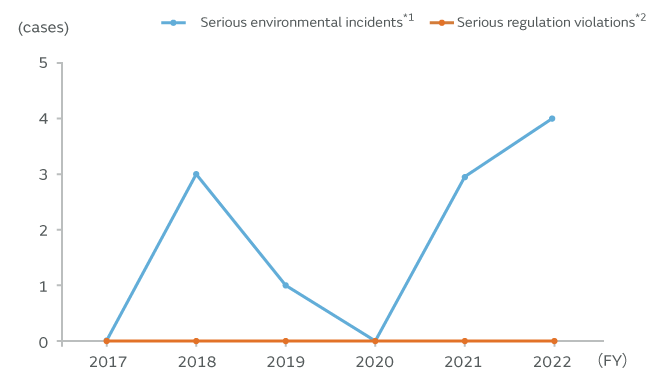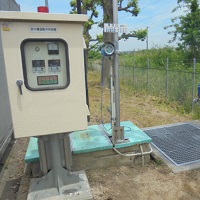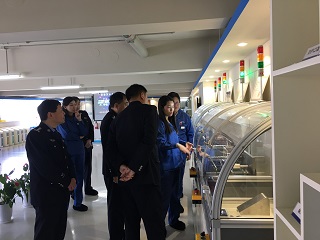Pollution prevention
Preventing environmental incidents and soil contamination
At Murata, we recognize that chemical substance contamination is a serious environmental risk. We have defined serious environmental incidents as "an incident exceeding the legally regulated values within our property boundaries," and have set targets to prevent such incidents from occurring.
During fiscal 2022, four serious environment incidents occurred due to liquid chemical substance leaks. Small amounts of light oil or sewage exceeding the legally regulated values within our property boundaries were leaked during these incidents. However, none of these incidents caused a serious negative impact on the environment of our neighbors, or resulted in administrative actions such as production stoppages, fines, or cleanup orders.
There were also no serious regulation violations in fiscal 2022 resulting in administrative actions or penalties such as production stoppages, fines, or cleanup orders.
This far, Murata has engaged in various initiatives such as conducting risk assessments when environmental incidents occur, and setting voluntary reference values to prevent chemical substances from leaking or splattering during storage or transport.
We will continue to promote initiatives to enhance current systems in order to further reduce the risk of environmental incidents occurring, such as strengthening efforts to identify risks and doing everything possible to prevent recurrence.
 Serious environmental incidents and serious regulation violations
Serious environmental incidents and serious regulation violations
-
*1
Serious environmental incident: An incident exceeding the legally regulated values within our property boundaries
-
*2
Serious regulation violation: An incident resulting in administrative actions or penalties such as production stoppages, fines, or cleanup orders
Voluntary rules for prevention
- Prohibition of underground storage tanks
In principle, storage tanks for new and waste fuels, organic solvents, and acids and alkalis, in addition to raw water tanks for wastewater treatment, will be located above ground. If it is unavoidable that a tank must be positioned underground, a double-walled tank must be used.
- Permeation barrier coatings
Locations in which fuels, as well as new and waste organic solvents, and acids and alkalis are handled will be provided with beds treated with a permeation barrier coating or made of stainless steel.
- Prohibition of underground piping
Pipes for transporting fuels as well as new and waste organic solvents, acids and alkalis, and waste liquids from industrial processes, will be located above ground.
- Emergency containment structures
Operational areas in which new liquids are received from tanker trucks, etc. or waste liquids are discharged will be provided with a structure that allows immediate containment of any leakage outside the area if an incidents occurs.
- Setting environmental incident levels
At Murata, we set three levels for environmental incidents and regard everything from exceeding the legally regulated values within our property boundaries to leaks of chemical substances within buildings as an environmental incident. We strive to prevent major incidents from occurring by identifying even the smallest leaks of chemical substances within buildings, analyzing the causes, and taking corrective action.
- Measuring the environmental impact emitted from worksites and setting voluntary reference values
We conduct periodic monitoring with respect to regulations on emissions from worksites under environment related laws. In addition, we voluntarily set reference values which are more stringent than the legally regulated values. We analyze the causes and take corrective action when those reference values are exceeded, and we build a mechanism that does not exceed the legally regulated values.
 Overhead piping at Toyama Murata Manufacturing
Overhead piping at Toyama Murata Manufacturing
 Truck yard at Philippine Manufacturing Co. of Murata, Inc.
Truck yard at Philippine Manufacturing Co. of Murata, Inc.
 Automatic shutdown valve at Tohoku Murata Manufacturing Co., Ltd.
Automatic shutdown valve at Tohoku Murata Manufacturing Co., Ltd.
Soil and groundwater contamination surveys and decontamination
Murata has been quick to carry out surveys on soil and groundwater contamination caused by past business activities and has actively worked toward early remediation.
Specifically, depending on the properties of the soil, the concentration of contamination, and the location of the contaminating source, we apply the in-situ bio method, the in-situ iron powder method, the in-situ oxidation and decomposition method, or other decontamination methods using state-of-the-art technologies to decontaminate the area according to the source of contamination. In addition, we install wells at the boundaries of the facilities in question to enable us to monitor the status of decontamination of the groundwater.
Control of emissions of air polluting substances
Volatile organic compounds (VOCs) are a cause of air pollution. Murata endorsed the efforts of four appliance and electronics organization including JEITA, began in 2000 installing regenerative thermal oxidizers (RTOs) at business sites with high VOC emissions, and has continued to voluntarily reduce 20 types of specific VOC emissions.
In response to global trends in regulations, we began in fiscal 2022 to increase the types of VOCs we aim to reduce*1, set company-wide VOC emission reduction targets (fiscal 2030 target: reduce 30% compared with fiscal 2021; fiscal 2024 target: reduce emissions below that of fiscal 2021), and continue promoting initiatives to further reduce emissions.
Our VOC emissions totaled 1,690 t in fiscal 2022, which is a reduction of 220 t compared with fiscal 2021
While VOC emissions are expected to increase along with production, we will continue to promote initiatives to install VOC removal equipment and also reduce the amount of VOCs used in our manufacturing processes, in order to achieve our VOC emission reduction target for 2030.
 VOC emission targets and results
VOC emission targets and results
Communications with local residents about environmental risk
We consider minimizing the impact of our business activities on local communities to be one of the most important aspects of our corporate social responsibility, and we work hard to respond swiftly if a problem occurs.
In fiscal 2022, the Murata group’s plants received seven complaints regarding noise and other matters, and we quickly resolved these issues in consultation with local residents.
We also strive to promote information disclosure, by such means as inviting local residents to tour our operating sites, so that they can better understand our active environmental efforts.
 Interaction with community members at Yasu Division
Interaction with community members at Yasu Division
 Company tour for community members at Wuxi Murata Electronics
Company tour for community members at Wuxi Murata Electronics
Chemical substance management
Murata's chemical substance management
Looking toward the realization of sustainable social systems, Murata strives to provide products with minimal impact on the global environment.
In addition to complying with laws such as RoHS and REACH regulations, Murata established voluntary reference values based on global trends in substances of concern and on requests from our customers. We also have set separate targets and are actively promoting initiatives to reduce or prohibit substances of concern in products, through the management system described below.
Targets and results
| Medium- to long-term goals
|
- FY 2024 targets: Product compliance violations: 0
Active reduction of environmentally hazardous substances contained in products
- FY 2030 targets: Product compliance violations: 0
Active reduction of environmentally hazardous substances contained in products
|
| Targets for fiscal 2022 to 2024 |
- Product compliance violations: 0
- Aim to strengthen chemical substance management governance.
- Actively reduce substances of potential concern contained in products.
- Quickly obtain the latest information on substances of concern, identify changes in social trends, and implement leading initiatives to achieve compliance.
|
| Fiscal 2022 results |
- There were zero compliance violations related to chemical substances contained in products.
- We conducted in-house training updated based on the latest trends, on the topic of managing chemical substances.
- We decided to further reduce the amount of lead in products as an voluntary initiative independent of regulations, and began investigating specific measures.
- Substances recommended for elimination during Stockholm Convention POPRC18 had been regulated since before 2021, and we confirmed that we have finished eliminating or replacing them.
|
Management system
Product designs that ensure that environmentally harmful substances are not used in excess of regulatory limits
Product development
Mechanisms restricting purchase of materials to suppliers from Whom information on substances used has been received and approved
Procurement
Examination of production equipment, etc. to ensure that environmentally harmful substances do not adhere to products
Manufacturing processes
Mechanisms to ensure that products that include banned substances cannot be shipped to customers that lack approval for handling such products
Shipments
We are also responding preemptively to the revision of laws relating to environmentally hazardous substances.
The Stockholm Convention on persistent organic pollutants (POPs), commonly referred to as the POPs Convention, is a framework for international cooperation aimed at reducing or eliminating typical substances of concern. During the 10th Conference of the Parties (COP10) held in June 2022, a decision was reached to add perfluorohexane sulfonic acid (PFHxS), its salts, and PFHxS-related compounds to "Annex A (Elimination)." Murata had voluntarily prohibited the use of PFHxS due to it having a similar level of toxicity as perfluorooctane sulfonic acid (PFOS) and its salts, which were added to "Annex B (Restriction)" during COP4 held in 2009.
In addition to managing chemical substances in products, we will also promote initiatives to reduce the risk of workers being exposed to chemical substances handled in manufacturing processes. As a priority initiative, we will promote an initiative regarding chemical substances used in cleaning applications to prohibit the inclusion of nine specified substances*1 by March 2025.
Link: Regulatory chart for environmentally hazardous chemical substances contained in products (excerpt)
Link: Regulatory chart for environmentally hazardous chemical substances used in manufacturing processes
Management of environmentally polluting substances
At Murata, we record data on the chemical substances we use in our Japan plants in a database, and we use a system that allows us to easily understand and manage the status of use of individual chemical substances.
We use this system for the discharge and transportation calculations required by the Act on Confirmation, etc. of Release Amounts of Specific Chemical Substances in the Environment and Promotion of Improvements to the Management Thereof (PRTR Law).
Of the 462 classes of substances that are subject to reporting under the terms of this law, in its Japan operations between April 1, 2022 and March 31, 2023, Murata used one ton or more of 30 classes of substances including toluene, xylene, and lead and lead compounds. The amounts used are shown below.
Volume of use and volume of discharge/transportation of PRTR substances (Total for Japan)